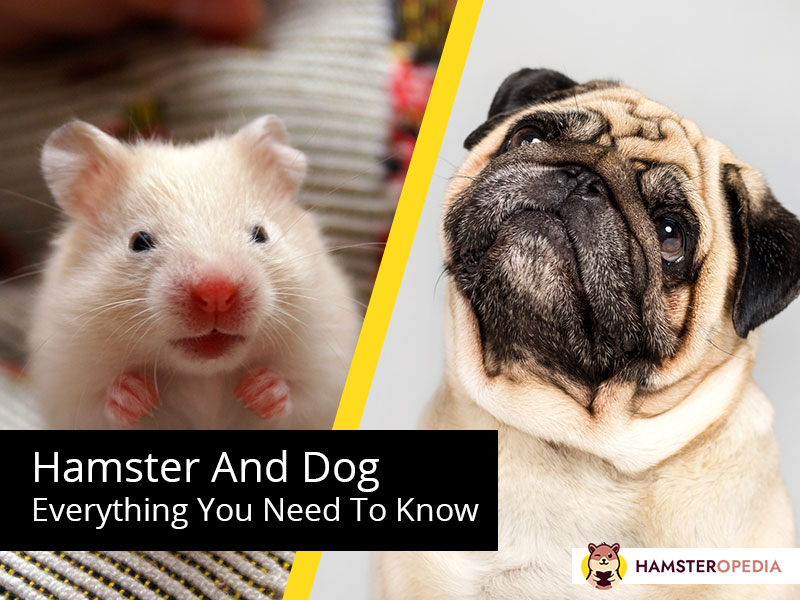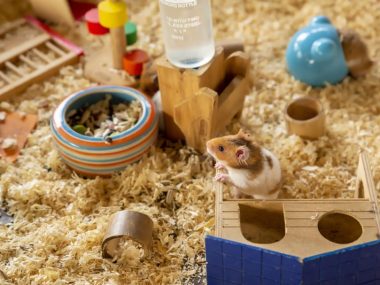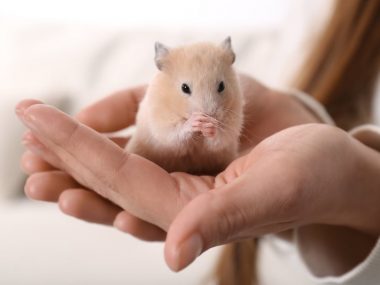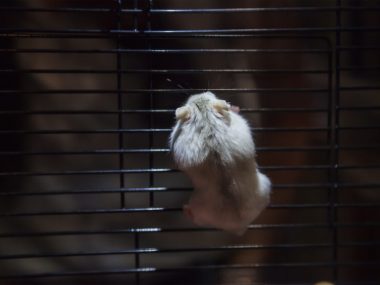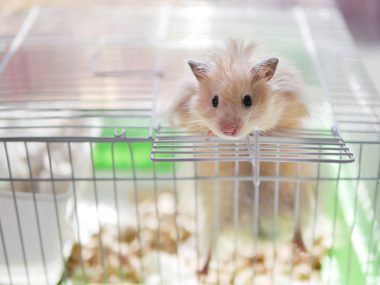It is sometimes hard to believe that our friendly, tail-wagging canine companions are closely related to wolves and jackals, which wouldn’t hesitate to devour a hamster in the blink of an eye. Fortunately, with the proper training and hamster setup, many pet owners are able to enjoy keeping a dog and a hamster.
It is possible to keep a hamster if you have a dog. Always keep the hamster’s safety as your top priority. Dogs should be introduced to the hamster slowly, and calm reactions should be rewarded. Keep the hamster cage out of reach and provide deep bedding so it can hide if it feels stressed.
Pets are fun, but they also have their own species-specific dynamics. A lot of times, they are still ruled by their natural wild instincts from before they were domesticated. Let’s find out more about how to keep a dog and hamster in one household.
Table of Contents
Dog And Hamster – Can I Keep Both?
According to Marge Gibbs, a canine behavior expert, a dog can be trained to accept the presence of a hamster, but only if you work at it. Dogs are naturally tuned into their surroundings and don’t miss much.
A dog doesn’t need to see your new hamster pal to know it is there. Dogs quite literally ‘see’ with their noses. According to a veterinary neurologist at Cornell University, dogs can have almost a billion nasal smell receptors, compared to just 5 million in humans.
Hamster owners must never forget that a tiny hamster is defenseless against predators like dogs and cats. Their natural defense would be to avoid them altogether, so bringing a predatory animal close to one of these small rodents can be highly stressful to them.
There are two elements that you need to consider when deciding if you can have a dog and a hamster as pets:
- Keeping the hamster physically safe from the dog. Fortunately, dogs are usually less agile than cats when it comes to climbing onto furniture. With mindful placement, you can often keep a hamster cage out of reach of a dog.
- Preventing the hamster from becoming stressed about the presence of a dog. A hamster has acute smell and hearing, and it will be able to detect that there is a potential predator in the vicinity. Its instinct will be to hide.
Before buying or adopting a hamster, check that your dog has a personality that would accept the new addition and that you have the time to train it. While your dog needs to learn to respect the hamster, you must also be able to keep the cage and its precious contents out of harm’s way.
If you already have a pet hamster and are deciding between a dog and a cat as an additional pet, your hamster is probably safer with a dog. One reason for this is that, unlike cats, dogs are social sleepers and are more likely to sleep when you do – unlike your lazy-looking housecat that spends all day napping and wakes up to hunt at the same time that your hamster starts energetically spinning on its wheel.
Do Dogs Get Jealous Of Hamsters?
Pet owners often incorrectly ascribe human emotions to their animals, but when it comes to dogs and jealousy, The Association For Psychological Science has confirmed that it is entirely founded. In a 2021 study, it was revealed that dogs get jealous even if they just think about their owners giving attention to a rival.

Unlike cats, dogs view themselves as part of a pack. Their human family is their pack, and they fit into the overall structure. Always give your dog plenty of love and pay attention to its body language when you are near the hamster so that it doesn’t feel like it is being demoted in status.
Some dog body language signs that may warrant immediate calm intervention include:
- Pricked-up ears and intent staring into the cage
- Panting while focusing on the hamster
- Growling or barking
- Jumping around excitedly while staring at the hamster – your pup may only want to play with the hamster, but one unexpected lunge at the small rodent would be fatal.
The most crucial part of all dog-hamster interactions is that the owner remains calm. Quietly remove the cage or distract the dog, so it moves away from the hamster.
Yelling or punishing the dog will only cause future resentment or fear. The goal must be for the dog to accept the hamster and view it as a family member to protect rather than a rival.
How Do I Get My Dog And Hamster To Get Along?
While a dog should never be trusted to interact with a hamster without supervision, with some training and plenty of positive reinforcement, it is possible to have the two share the same room without any excitement. Always keep your hamster inside its cage while the dog is close by – accidents can happen very quickly, and a hamster’s fragile body is no match for a dog’s powerful jaws.
Keep in mind that some dog breeds were selectively bred as hunting dogs, so it is in their nature to want to bring down prey for their humans. Some breeds, especially terriers, were specifically bred to hunt rodents, so it may be especially difficult to teach them that your beloved pet hamster isn’t vermin that needs to be eradicated.
Other hunting dog breeds that may be more difficult to train to ignore your pet hamster include:
- Spaniels
- Retrievers
- Setters
- Pointers
- American Foxhounds
How Can I Train My Dog To Get Along With My Hamster?
You may never be able to train your dog to love your hamster, and you should never leave it unsupervised with the small rodent, but you can certainly get them used to each other. Over time and with enough positive reinforcement, your dog will hopefully ignore your hamster.
Introducing your dog and hamster needs to be a slow process. This is what to do:
- Ensure the hamster is kept in a secure cage outside the dog-reach zone.
- Add plenty of hamster hideouts and keep deep bedding in the cage so the hamster can hide if it is fearful.
- Make sure there is no way your hamster could escape – the last thing you want is for the little pet to be on the loose with a dog around.
- When you get the hamster, keep the dog outside the room. Let it sniff the hamster’s scent under the door.
- After a few days, rub a piece of roller towel or small cloth in the hamster bedding and let the dog sniff it. Praise the dog and reward it for remaining calm while smelling the hamster’s scent.
- Next, take the dog into the hamster’s room on a leash and tour the room. The dog doesn’t have to see the hamster – its nose will let it know where it is. Only stay in the room for a few minutes like you are just passing through. Don’t make a big deal of the hamster. Reward the dog for calm behavior and exiting without a fuss.
- Repeat the room tours a few times a day until both animals get used to the routine.
- All good things take time, so don’t rush the process. Only reward the dog for desirable behavior, stay calm, and distract it if it gets hyped up. If your dog gets overly excited or the hamster acts fearful, try again later.
- Don’t ever dig the hamster out of its bedding to ‘show’ the dog. It would be terrifying for the small rodent, and the dog may think you are showing it what you want it to do.
- Always remain cautious. A friendly dog may just be trying to pick the hamster up if it is on the ground and accidentally crush it, so always keep your little hammie friend out of harm’s way.
Is Hamster Poop Harmful To Dogs?
If you have a dog that never leaves your side, you may be horrified if it picks up a mouthful of dirty hamster litter while you are cleaning the cage. Fortunately, hamster poop isn’t toxic to dogs, but it may contain parasites.
Intestinal worms are the most likely condition that may result if your hamster is infected. That is also why hamster owners should always wash their hands carefully after handling their small pet or cleaning the cage.
Hamsters are more likely to give each other diseases than other animals or humans…unless, of course, someone eats their poop! If your dog does manage to gobble down a bit of hammie poop while you are not looking, it is a good idea to give it a tapeworm dewormer in case, but other than that, your dog will be fine.
What Animal Gets Along With Hamsters?
Hamsters can be described as the ultimate Billy no-mates! They are solitary animals that don’t long for the company of other animals, and in fact, most of them can barely tolerate other hamsters. The best companion for a hamster is its human owner. There is no need to get a companion for a pet hamster. So long as it has a stimulating, clean environment and gets taken out as enrichment and to bond with its owner, a hamster will be perfectly happy.
